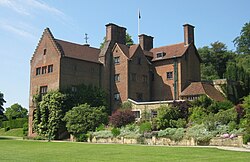
Back Chartwell Czech Chartwell German Chartwell Esperanto Chartwell Basque چارتول (خانه) Persian Chartwell French צ'רטוול HE Չարթվել Armenian Chartwell Italian チャートウェル Japanese
| Chartwell | |
|---|---|
 Chartwell House | |
| Type | House |
| Location | Westerham, Kent |
| Coordinates | 51°14′39″N 0°05′00″E / 51.2443°N 0.0833°E |
| Built | 1923–24, with earlier origins |
| Architect | Philip Tilden |
| Architectural style(s) | Vernacular |
| Governing body | National Trust |
Listed Building – Grade I | |
| Official name | Chartwell |
| Designated | 16 January 1975 |
| Reference no. | 1272626 |
| Official name | Chartwell Garden |
| Designated | 1 May 1986 |
| Reference no. | 1000263 |
Chartwell is a country house near Westerham, Kent, in South East England. For over forty years it was the home of Sir Winston Churchill. He bought the property in September 1922 and lived there until shortly before his death in January 1965. In the 1930s, when Churchill was out of political office, Chartwell became the centre of his world. At his dining table, he gathered those who could assist his campaign against German re-armament and the British government's response of appeasement; in his study, he composed speeches and wrote books; in his garden, he built walls, constructed lakes and painted. During the Second World War, Chartwell was largely unused, the Churchills returning after he lost the 1945 election. In 1953, when again prime minister, the house became Churchill's refuge when he suffered a debilitating stroke. In October 1964, he left for the last time, dying at his London home, 28 Hyde Park Gate, on 24 January 1965.
The origins of the estate reach back to the 14th century; in 1382, the property then called Well-street was owned by William-at-Well. It passed through various owners and in 1836 was auctioned, as a substantial brick-built manor. In 1848, it was purchased by John Campbell Colquhoun, whose grandson sold it to Churchill. The Campbell Colquhouns greatly enlarged the house and the advertisement for its sale at the time of Churchill's purchase described it as an imposing mansion. Between 1922 and 1924, it was rebuilt and extended by the society architect Philip Tilden. From the garden front, the house has extensive views over the Weald of Kent, "the most beautiful and charming" Churchill had ever seen, and the determining factor in his decision to buy the house.
In 1946, when financial constraints forced Churchill to consider selling Chartwell, it was acquired by the National Trust with funds raised by a consortium of Churchill's friends led by Lord Camrose, on condition that the Churchills retained a life-tenancy. After Churchill's death, Lady Churchill surrendered her rights to the house and it was opened to the public by the Trust in 1966. A Grade I listed building, for its historical significance rather than its architectural merit, Chartwell has become among the Trust's most popular properties; 232,000 people visited the house in 2016, the fiftieth anniversary of its opening.
